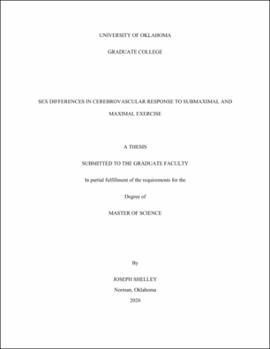| dc.description.abstract | Dysfunctional cerebrovascular control is closely linked to the increased incidence of cerebrovascular and neurodegenerative diseases (e.g. dementia and Alzheimer’s). Epidemiological evidence identifies sex-specific differences in the course of prevention (risk factor) and treatment (prognosis) of cerebrovascular and brain diseases. Therefore, examining sex differences in cerebral blood flow (CBF) regulation is essential. Despite previous studies identifying muscle blood flow sex discrepancies to both handgrip and knee extensor exercise, CBF responses during exercise in women are underrepresented in the literature. Therefore, it remains unclear if sex differences in cerebrovascular control to exercise exists. Purpose: Address whether cerebrovascular responses were different between men (MN) and women (WM) during a graded exercise test (GXT) and provide better insight into the relationship between sex and cerebrovascular reactivity at differing exercise intensities. Methods: 26 young healthy adults (13 WN, 24.2±3.6 yrs) completed a graded-exercise-test (GXT, stage length 3-min, 50W, 75W, 100W; after which MN increases by 40W, WN increased by 30W maintaining 60-80 RPM) on a recumbent cycle ergometer to volitional exhaustion. The highest completed stage was determined as Maximal Wattage (Wmax). Middle cerebral artery velocity (MCAv; transcranial Doppler ultrasound) and mean arterial pressure (MAP; finger photoplethysmography, CPP was calculated MAP – [0.7355* vertical distance of TCD probe from heart-level]), were measured on a beat-by-beat basis to calculate CVCi = MCAv/CPP*100mmHg. End-Tidal CO2 (ETCO2) was also collected (Gemini Gas Analyzer). Results: Mean ± SD, MN and WN exhibited similar MCAv responses to changes in exercise intensity with peak MCAv obtained ~ 60% Wmax (ΔMCAv, WN = 18.4 ± 5.0, MN = 15.8 ± 3.1 cm/s, p = 0.07) and declined as intensity increased. There was a trend for WN to have a greater ΔMCAv with increasing relative exercise intensity (p = 0.06) with the greatest difference between WN and MN observed at 100%Wmax (ΔMCAv, WN= 11.0±2.2, MN= 5.9±3.2 cm/s, p<0.01). Interestingly, MN had a greater exercise cerebral prefusion pressor response with increasing exercise intensity (p < 0.01) with the largest difference being observed at 100% Wmax (ΔCPP, WN 35.8±5.3, MN 44.7±9.6 mmHg, p < 0.01). Additionally, WN experienced greater CVCi (p<0.01) at higher exercise intensities compared to MN, with the greatest difference observes at 100% Wmax (ΔCVCi, WN= -22.5±10.9; MN= -31.5±7.2 cm/s/100mmHg, p<0.01). There was no difference in ETCO2 across the entire GXT (p=0.40). Conclusion: Young females were able maintain MCAv in response to GXT through increased CVCi, while young males were able to sustain similar MCAv values through significant increases in CPP. Additionally, the similar ETCO2 values between groups suggests either the sex-linked mechanistic differences in cerebrovascular response GXT independent of ETCO2. | en_US |
